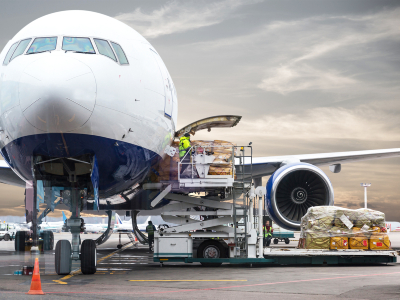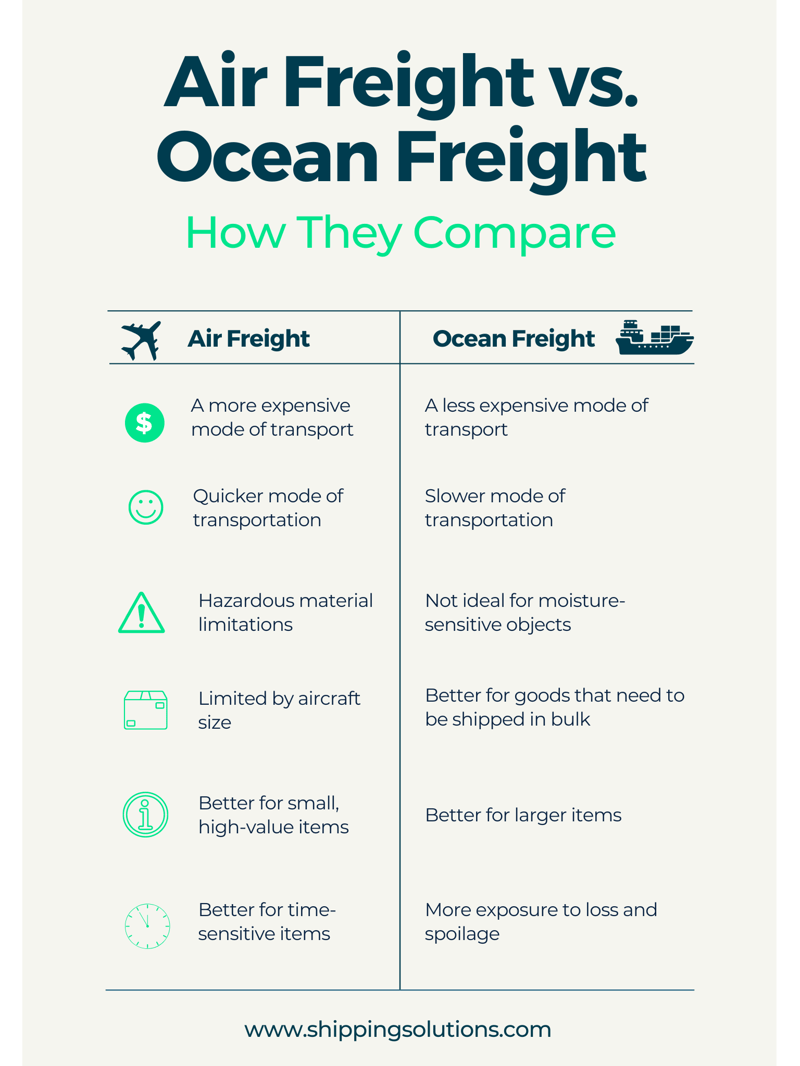The International Trade Blog International Logistics
International Air Freight: An Overview
On: August 22, 2022 | By:  David Noah |
5 min. read
David Noah |
5 min. read
 As the global economy continues to grow, buyers will continue to expect the rapid transit of goods via air freight. In the United States, air cargo freight was a $122.96 billion industry in 2021; it is poised to continue its growth into the next decade.
As the global economy continues to grow, buyers will continue to expect the rapid transit of goods via air freight. In the United States, air cargo freight was a $122.96 billion industry in 2021; it is poised to continue its growth into the next decade.
Below, Robert Khachatryan, CEO and founder of Freight Right Global Logistics, shares some information around the basic concepts of air freight for exporters: What can be shipped via air? How much does it cost? What are the best use cases for this type of transportation?
What is air freight shipping?
Air freight can be defined as products and goods (cargo) that are shipped by aircraft.
Options for modes of air freight include passenger aircraft, the cargo hold of a passenger aircraft or a commercial cargo aircraft. Air freight transportation begins at the airline terminal, where the air freight company you’ve selected receives the cargo. It is then prepared and loaded into the aircraft.
Airlines offer multiple services for air freight transportation.
- General cargo: This is the most economical option, where goods are loaded into the “belly” of the aircraft.
- Priority service: This is sometimes called “first flight out” service.
- Over-the-counter service: With this type of freight by air, you drop your goods at the airline terminal.
- Hand carry service: This is the most expensive option; someone takes your package and flies with it. Hand carried air freight is typically reserved for documents, high-value shipments and expensive goods.
Commercial cargo is a separate service from passenger airline cargo, where the entire plane is a cargo hold—essentially, a giant flying container. Typically, commercial cargo includes large palletized cargo, boxes, coffins/human remains, vehicles, machinery and sometimes animals (even orca whales!).
How long does air freight transportation take?
Air freight transportation time depends on your location and the destination of your goods. It’s possible for cross-country air freight to arrive at a destination within six to seven hours for critical services, while international shipping may take just a bit longer. Keep in mind that this is just for the air transportation—goods will also need to be transported to the aircraft and to the destination once the aircraft has landed. While air freight is the fastest way to export goods, in cases of disruptions and shutdowns, goods may take up to a week or longer to arrive at their destination.
What can be shipped by air?
While nearly anything can be shipped by air, two factors—speed and expense—tend to determine what is typically shipped by this method. Here are the most common goods shipped by air:
- Pharmaceuticals.
- Produce and perishable agricultural products.
- Seafood.
- Just-in-time production and emergency shipments of parts.
- Seasonal items with a short shelf life (like cherries in the United States).
- Plants and flowers.
- Documents.
- Production samples.
- Electronic consumer goods.
What cannot be shipped by air?
Some goods are too big or too heavy to be shipped in a plane. Aside from the obvious factors that play into air freight, there are many regulations for goods on aircraft—flammable, hazardous and other dangerous goods, including magnets, batteries and cellphones, have significant regulations around them, and while some are able to be shipped by air, some are not. Each airline has different policies about what they will and will not accept. The FAA is also a key player in determining exemptions for what may be carried on aircraft.
In the U.S., TSA and FAA regulations govern air freight. Exporters who wish to ship their goods domestically and internationally need to seek the counsel of their freight forwarder to make sure they understand and comply with all rules and regulations. A freight forwarding partner will also help shippers fill out documentation and can be employed to properly package goods if needed.
How are air freight rates calculated?
Air freight is the most expensive way to ship your goods. Typically, air cargo rates are calculated by weight. In most cases, the air freight itself (carriage of goods) is based on volumetric weight—the volume of the shipment factors into the weight. (You wouldn’t pay the same price to ship a pallet of bricks and a pallet of foam; volumetrically, 50 pounds of styrofoam looks very different than 50 pounds of bricks.)
Industry standard formulas help you derive these chargeable volumetric weights, and pricing varies based on airlines and whether the flights are domestic or international. In addition to weight, flat fees for handling, documentation, customs clearance and charges to pick up and deliver goods are involved.
According to The World Bank, the demand for air freight is limited by cost, typically priced four to five times that of road transport and 12 to 16 times that of sea transport. Air freight rates generally range from $1.50–$4.50 per kilogram, while the value of air cargo typically exceeds $4.00 per kilogram.
Air Freight vs. Ocean Freight: What are the differences?

Use Case for Air Freight
While not all goods should be shipped by air, there are many use cases when goods would be best suited to ship by air freight. Instances where this is the case include:
- The goods are expensive or have high value. Very valuable goods or those that require strict control and shorter transit time should be shipped by air to limit exposure to loss. The more expensive the goods, the lower the percentage of the landed cost would be attributed to the shipping.
- You’re exporting small products. It is more cost effective to ship via air freight if the goods are smaller.
- You need to deliver a product within a limited time window. If time is critical, or if you have a specific deadline for delivery, air freight is a better choice because it is more consistently on time. Estimated arrivals for air cargo are often just a few days off target if they are delayed at all; ocean containers may be stuck at port for weeks, and transportation to and from the port can sometimes be delayed.
- The products are unable to withstand the elements of the ocean. If your products cannot withstand dampness (for example, cardboard absorbing moisture, sensitive electronics, etc.), you should consider shipping by air.
Our thanks to Robert Khachatryan for his assistance with this article. Freight Right Global Logistics is hazardous goods certified, trained and experienced in air freight transportation—click here to learn more about its air freight transportation and other freight forwarding services.
Like what you read? Subscribe today to the International Trade Blog to get the latest news and tips for exporters and importers delivered to your inbox.

About the Author: David Noah
As president of Shipping Solutions, I've helped thousands of exporters more efficiently create accurate export documents and stay compliant with import-export regulations. Our Shipping Solutions software eliminates redundant data entry, which allows you to create your export paperwork up to five-times faster than using templates and reduces the chances of making the types of errors that could slow down your shipments and make it more difficult to get paid. I frequently write and speak on export documentation, regulations and compliance issues.


